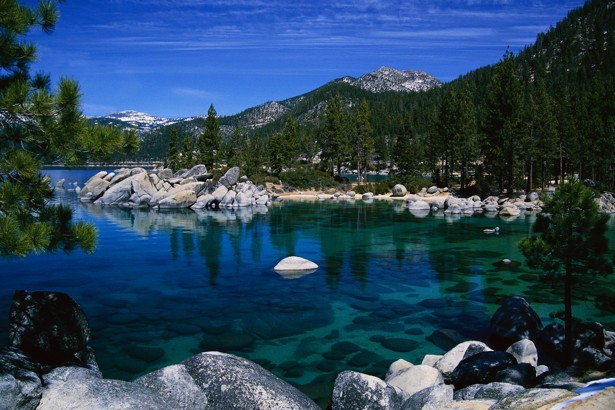
Lake Tahoe is famous for its blueness, a fact that’s celebrated on slick bumper stickers and in buckets of thick paint.
“A noble sheet of blue water,” Mark Twain wrote of Lake Tahoe in 1871, “As it lay there with the shadows of the mountains brilliantly photographed upon its still surface, I thought it must surely be the fairest picture the whole earth affords.”
The striking hue is one thing, but Tahoe also has splendid clarity. Or it did, anyway. For decades, as Lake Tahoe gradually became murkier, scientists have struggled to understand why. In the 1960s, visibility through the waters of Lake Tahoe was about 90 feet; by the early 2000s it was down to 60 feet, according to NASA, which has monitored the lake’s environment using buoys rigged up to satellites since 1999. (The buoys are also in place to help NASA make sure its satellite measurements are calibrated properly.)
Worse clarity, many assumed, would make for a less vibrant blue.
Scientists now believe they understand a key component of what gives Lake Tahoe its colorful pop. It isn’t the clarity, but a lack of algae that makes for the distinctive color. Even more surprising: Clarity and blueness seem to be at odds with one another. Scientists at the University of California at Davis included the first-ever “quantification of Tahoe’s blueness,” based on measuring of the wavelength of light coming from the lake, in this year’s State of the Lake report.

“While water clarity and lake blueness have long been considered to be one and the same, a newly developed Blueness Index has shown that this is not the case,” they wrote. “On the contrary, at times of year when clarity increases, blueness is seen to decrease.”
In the winter, when algae concentration goes up by a factor of two or three, the lake appears less blue. But for the past three years overall, Lake Tahoe has been getting bluer and the longer-term loss of clarity has stabilized. “What the research is revealing is that while clarity is controlled by fine particulates, blueness is controlled by algal concentration,” the researchers wrote. “The lower the algal concentration, the bluer the lake.” Tahoe contains, they said, 30 million-trillion algal cells—about 15,500 tonnes of the stuff. A sort of weird visualization that might help: That’s enough algae to stack nine-feet-high across a football field.
So what’s the best way to keep Tahoe blue and clear? The two phenomena are still, in some ways, connected. Researchers have identified a number of pollutants—fine particles found in stormwater—that make a difference for clarity. A high volume of nutrients in that same stormwater could help feed the algae that diminishes blueness.
In addition to tracking algal concentrations, scientists are measuring turbidity, temperature, wave height, and dissolved-oxygen concentration in the lake. And while science can help explain much of what makes it unique, appreciating a body of water as spectacular as Lake Tahoe calls for a literary sensibility like Twain’s. “Three months of camp life on Lake Tahoe would restore an Egyptian mummy to his pristine vigor, and give him an appetite like an alligator,” he wrote in 1871. “ I do not mean the oldest and driest mummies, of course, but the fresher ones.”